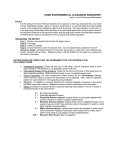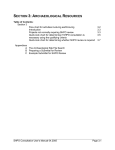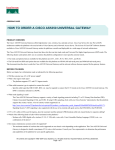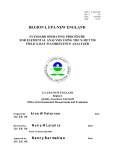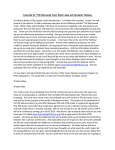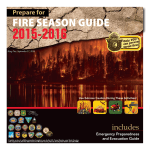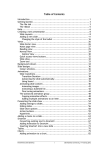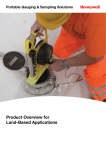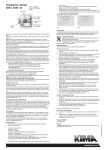Download Environmental Clearance Worksheet-Non
Transcript
ENVIRONMENTAL CLEARANCE WORKSHEET (use by Non-Profit and For Profit (Non-Public) Recipients) POLICY It is the policy of the Iowa Finance Authority (IFA) not to approve or fund any proposals that, as a result of their identifiable impacts, direct or indirect, would lead to or accommodate the irreconcilable impact on the assessment categories listed in this document. The only exception to this policy is if the approving official determines that there is no practicable alternative to the proposed actions, the proposal conforms to the planning criteria, and the proposal includes all practicable measures for reducing the impact in accordance to the corresponding federal regulation. ORGANIZING THE REPORT Page 1: Create a coversheet that includes the project name Page 2: This page Page 3: Table of Contents Page 4: Answer Sections I and II in narrative form. Do not include these questions in the EA. Remaining Pages: Complete Section III using this document or create your own following this format. All items with a (bullet •, italicized, and/or in BLUE PRINT) do not need to be copied into the final EA document. INSTRUCTIONS FOR COMPLETING THE ASSESSMENT FOR THE CRITERIA IN THE FOLLOWING PAGES: Assessment Questions: These will lead you to the rating. Not all questions apply to each type of project, if the question is not applicable answer with N/A. Informational Sheets, Forms & Notices: These can be found at the back of this assessment in their respective sections. Attach those that apply to your completed assessment. Source information: For each assessment criteria please list the informational source, which could be a person or where this information can be obtained. Also, create an appendix section for each criterion for the supporting documentation. Mitigation: If mitigation is required describe the proposed mitigation measures in the space provided under each criterion. Mitigation measure must be practicable and enforceable. Rating: Evaluate the proposed activity using the following rating system in terms of actual or potential impacts on the environment. 0= 1= 2= 3= 4= N/P = No Impact Anticipated Potentially Beneficial Impact Potentially Adverse Impacts: impacts which can be easily mitigated with minimal expense or delay in project implementation Moderate Adverse Impacts: impacts which can be mitigated through use of special measures which may add extra costs to the project or result in a short delay of project implementation Major Adverse Impacts: impacts which cannot be mitigated or which would require extensive mitigation techniques which would be very costly and/or which would result in long delays in project implementation. Resource Not Present: after investigation. TABLE OF CONTENTS I. Purpose and Need for the Project A. Project Description B. Need for the Project II. Alternatives to the Proposed Action III. Environmental Resources A. B. C. D. E. F. G. H. I. J. K. L. M. N. O. P. Q. General Land Use Important Farmland, Prime Rangeland, and Prime Forest Land Wild Scenic Rivers, Formally Classified Lands, Natural Landmarks Wilderness Areas Floodplains Wetlands Cultural Resources, Historical and Archaeological Biological Resources Critical Habitat Endangered/Threatened Species Act Water Supply & Quality & Groundwater Coastal Zone Management Area & Coastal Barrier Resources System Storm Water Waste Water Surface Water Socio-Economic Information/ Environmental Justice Issues Air Quality Transportation Noise Hazardous Waste IV. Summary of Findings and Conclusions V. Citizen Participation VI. Conclusion I. PURPOSE AND NEED FOR THE PROJECT Provide a description of the proposed project summarizing all proposed improvements and construction activities. Include a map of the project site. Clearly and definitively demonstrate the purpose and establish a need for the project. How was the need determined for an Environmental Assessment? Give a brief description of existing environmental conditions and trends likely to occur without implementation of the proposed activity. II. ALTERNATIVES TO THE PROPOSED ACTION Discuss the reasonable alternatives considered and present the evaluation factors considered in judging each alternative’s ability to meet the described purpose and need of the proposed project. Including a discussion of the “no action” alternative. III. ENVIRONMENTAL RESOUCE CRITERIA: The following information is required and shall be addressed in the Environmental Assessment. A. GENERAL LAND USE Assessment Questions: 1. Is the project consistent with local, regional or state comprehensive plans, polices, ordinances, and goals? 2. Does the proposed project comply with existing zoning regulations? 3. What are the existing land uses adjacent to the proposed project? Classify and estimate the number of affected land areas by type of current land use such as residential, commercial, agricultural, rangeland, forestland, etc. 4. Does the community (neighbors) think the proposed project will be compatible with existing uses? 5. What is the total land area required or proposed for purchase and the amount of land that will be disturbed by construction and operation? 6. Will the proposed project contribute to urban sprawl? 7. Will the additional school age children in the proposed development exceed the capacity of the existing or planned school facility? 8. Do local retail services meet the needs of project occupants/users? Are social services currently located in close proximity to the prospective users/residents? 9. Are non-emergency and emergency health care services located within a reasonable proximity to the proposed project? Mitigation: Describe the mitigation measures (if necessary): Documentation: Supporting documentation can be found in Appendix A copy of the Zoning Ordinance can be obtained at Impact Category Conformance with Comprehensive Plans and Zoning Compatibility and Urban Impact Rating Date/Name/Title of Contact or Informational Source B. IMPORTANT FARMLAND Assessment Questions: 1. What is the zoning of the project property? Document the source. 2. If this land is zoned agricultural is the land “committed” to urban development or water storage, this includes land that has been zoned for other uses besides agriculture even if it is currently being farmed? 3. If the property is zoned for agricultural use is this land considered Prime Farmland? •The Farmland Protection Policy Act of 1981 (regulation 7 CFR Part 658) states that federal programs will minimize the extent to which they contribute to the unnecessary conversion of farmland to on agricultural uses. Check the NRCS Important Farmland List to determine if the land is considered important farmland. The list can be found at www.nrcs.usda.gov/technical/efotg/ Once you’re on the website here’s how to access the list: Click on Iowa on the US Map A map of Iowa will pop up, click on your county of interest At the right side of the page you will see a bar – find Section II folder and click click on A: Soils Information folder click on 1. Soil Survey Area folder click on your county name folder click on Soils Tables folder click on the Prime Farmland List folder The Prime Farmland List will come up; print this using the printer icon at the top of the document, not your web browser. Using a County Soil Survey (these can be obtained from County NRCS offices) compare the soils at the project site to those on the list. Be sure to save the list with your environmental assessment. If you find an important farmland soil, complete the Farmland Conversion Impact Rating Form (Form AD-1006) or the Farmland Conversion Impact Rating For Corridor Type Projects Form (SCS-CPA-106) (whichever is appropriate) found in the Form Section of this assessment. Complete PART VI of the form, if the score is less than 60, assume 100 points for PART III and make a determination of no important farmland. If PART VI is 60 or more points then send the form to the project county USDA Natural Resource Conservation Service office for completion of part III. A list of NRCS county contact numbers can be found at http://www.ia.nrcs.usda.gov/contact/ If the project will impact Important Farmland mitigation measures are required. The following is an example of mitigation measures when a water or sewer utility line will cross or parallel Important Farmland. Important Farmland has been identified and shall be protected from conversion. Water/Sewer service shall be restricted in areas classified as Important Farmland to agricultural uses or single family size service only. The City/County can change the classification by designating the area as future growth or rezoning the area. HUD Questions and Answers http://www.hud.gov/offices/cpd/environment/review/qa/farmlandprotection.cfm www.gov/local/shared/working/r10/environment/farmland.doc Mitigation: Describe the mitigation measures (if necessary): Documentation: Supporting documentation can be found in Appendix Including: The completed NRCS Farmland Conversion Impact Rating Form (if necessary) OR County Prime Farmland list and soils map of the project site Impact Category Agricultural Lands Farmland Protection Policy Act of 1981 7 CFR Part 658 Rating Date/Name/Title of Contact or Informational Source C. WILD AND SCENIC RIVERS, FORMALLY CLASSIFIED LANDS, NATURAL LANDMARKS AND WILDERNESS AREAS– PRIME RANGELAND – PRIME FOREST LANDS Assessment Questions: 1. Is the proposed project adjacent to any of the following (all are considered formally classified lands)? National parks and monuments, National natural landmarks, National battlefield park sites, National historic sites and parks, Wilderness areas, Wildlife refuges, National seashores, lake shores, and trails; State parks, Bureau of Land Management (BLM) administered lands, National forest and grasslands, and Native American owned lands and leases administered by the Bureau of Indian Affairs (BIA). A. The National Park Service web site can be found at: http://home.nps.gov/applications/parksearch/state.cfm Click on Iowa to locate national monuments, national historic sites, and historic trails. B. For wildlife refuges and wilderness areas access the Iowa DNR website at: http://www.iowadnr.gov/wildlife/wmamaps/pubhunt.html Click on the County initial. C. For State Parks and State Preserves access the Iowa DNR website at: http://iowadnr.gov /index.html/ Click on State Parks and/or State Preserves. D. For County Parks see the County Conservation Board website at: http://george.ecity.net/iaccb/links.htm Click on a County web page. Some counties do not have web sites. At the bottom of the page is a County Conservation Board, click and find county and call county, document call. If No, then document the source used to make the determination. If yes, provide information on the amount of each type of such lands that will be affected by the proposed project, type of effect (direct, indirect, and cumulative), and the alternatives considered. 2. Iowa does not have any Wild and Scenic River as defined under the Wild and Scenic Rivers Act of 1968 (16 U.S.C. 1271) as referenced at the National Park Service website http://www.nps.gov Are any State of Iowa important protected water areas affected by this project? See informational sheet E for list of Iowa protected water areas. 3. There are not any formally designated rangelands in Iowa. Are any state rangelands and forestlands affected by this project? Check the DNR website at www.iowadnr.gov/forestry/forests.html. 4. Are recreation and local community points of interest within close proximity to the project location? If yes, how will the project affect these resources? HUD Questions and answers: www.hud.gov/offices/cpd/environment/review/rivers.cfm www.hud.gov/offices/cpd/energyenviron/envirment/compliance/qa/rivers.cfm Mitigation: Describe the mitigation measures (if necessary): Documentation: Supporting documentation can be found in Appendix Impact Category Rangelands and Forestlands State Protected Water Areas Formally classified lands, Recreation, Points of Interest Rating Date/Name/Title of Contact or Informational Source D. FLOODPLAINS Assessment Questions: 1. Will the project be located in the 100-year floodplain or designated floodway? IFA will not allow a project located in the 100 year floodplain. 2. Is the project a critical action located in the 500-year floodplain? Use FEMA Flood Hazard Boundary Maps/Flood Insurance Rate Maps to make the determination. They are available for review in Rural Development State, Area, and Local Offices or can be ordered on the web at www.store.msc.fema.gov. If the proposed location of the project is not mapped by FEMA, check the NRCS web site at www.nrcs.usda.gov/technical/efotg to determine if the soil type is subject to flooding. Once you are on the website here is how to access the list: Click on Iowa on the US Map A map of Iowa will pop up, click on your county of interest At the right side of the page you will see a bar – find Section II folder and click click on A: Soils Information folder click on 1. Soil Survey Area folder click on your county name folder click on Soils Tables folder click on the water feature folder The Water Feature list will come up; print this using the printer icon at the top of the document, not your web browser. The terms utilized under the flood section are; frequent = 100 year, occasional = 500 year, and none. Using a County Soil Survey (these can be obtained from County NRCS offices) compare the soils at the project site to those on the list. Be sure to save the list with your environmental assessment. Determine if the project location is in a 100-year floodplain or a critical action in the 500-year floodplain. A critical action is defined as an action which, if located or carried out within a floodplain, poses a greater than normal risk for flood-caused loss of life or property. That is, if flooded, the proposed project could create an added dimension to the disaster, with the result being a greater than normal loss of life or property. If the property has a wetland or floodplain on it and it can be documented that the project will not impact the wetland or floodplain alternative sites do not need to be considered. To be in compliance with E.O. 11988 (regulation 24 CFR Part 55) requirements, federal funds should not be used for direct or indirect support of floodplain development if there is a feasible alternative. Complete the 8-step process found in Informational Sheet C to evaluate practicable alternatives. If in a floodplain, appropriate permits will be required. HUD Questions and Answers: www.hud.gov/offices/cpd/environment/review/floodplain.cfm www.hud.gov/offices/cpd/energyenviron/environment/subjects/floodwetlands/index.cfm www.hud.gov/local/shared/working/r10/environment/floodplain.doc Mitigation: Describe the mitigation measures (if necessary): Documentation: Supporting documentation can be found in Appendix Including: A photocopy of the FEMA Flood Hazard Boundary Maps/Flood Insurance Rate Map or the NRCS soil map for the project site and flood prone soil list. A completed FEMA Standard Flood Hazard Determination (FEMA Form 81-93, Oct 02) (this form can be found at http://www.fema.gov/business/nfip/ If appropriate, a map showing the proposed utility lines, appurtenances, and facilities. If appropriate, a copy of the topographical map for the site. Impact Category Floodplains E.O. 11988 (24 CFR Part 55) Rating Date/Name/Title of Contact or Informational Source NOTE: Don’t forget to publish floodplain notices if project occurs in a floodplain . E. WETLANDS Assessment Questions: 1. Will the proposed project affect or be affected by a wetland? Wetlands are those areas that are inundated or saturated by surface or ground water at a frequency and duration sufficient to support, and that under normal circumstances do support, a prevalence of vegetation typically adapted for life in saturated soil conditions. Wetlands generally include swamps, marshes, bogs, and similar areas. The following two methods must be used to determine if a wetland is present on a proposed site: a. Use the U.S. Fish and Wildlife Service, Department of the Interior National Wetlands Inventory Maps to make the determination available at http://wetlandsfws.er.usgs.gov/ Print a copy of the map for the environmental file. If a designated wetland appears at the project site contact the U.S. Fish and Wildlife Service, Rock Island Field Office at (309) 7935800. b. and, Check the NRCS list for Hydric soils at: www.nrcs.usda.gov/technical/efotg Print a copy of the Hydric Soils list for the environmental file. Once you are on the website here is how to access the list: Click on Iowa on the US Map A map of Iowa will pop up, click on your county of interest At the right side of the page you will see a bar – find Section II folder and click click on A: Soils Information folder click on 1. Soil Survey Area folder click on your county name folder click on Soils Tables folder Click on the Hydric Soils List folder The Hydric soils List will come up, print this using the printer icon at the top of the document, not your web browser. Using a County Soil Survey (these can be obtained from County NRCS offices) compare the soils at the project site to those on the list. If you find indications of a wetland you must have someone qualified in wetland determination prepare a report. The U.S Army Corp of Engineers is responsible for wetland permitting. They use the 1987 Wetlands Delineation Manual to make a determination (available at www.usace.army.mil/public.html#Regulatory ). If the project site is farmland the NRCS can make the wetland determination. If the site is non-farmland a private consultant can be hired to make a determination (IDED at 515-242-4855 has a list of consultants). If you have questions about wetland determinations and delineations contact Neil Johnson at the U.S. Army Corp. of Engineers at 309-794-5379. If the project location will be in a wetland alternative sites shall be considered. In order to be in compliance with E.O. 11990, (regulation 24 CFR Part 55) requirements, federal funds should not be used for direct or indirect support of new construction in wetlands if there is a feasible alternative. Refer to Informational Sheet C to evaluate alternatives. Attach the evaluation of alternatives considered in the appendix 2. Will the proposed project involve dredging or filling in a wetland? If so, contact the U.S. Army Corps of Engineers concerning a permit. Mitigation: Describe the mitigation measures (if necessary): Documentation: Supporting documentation can be found in Appendix Including: A copy of the National Wetlands Inventory Map AND County Hydric Soils list and soil map for the project site Attach the evaluation of alternatives considered. Impact Category Wetlands E.O. 11990 (24 CFR Part 55) Rating Date/Name/Title of Contact or Informational Source NOTE: Don’t forget to publish wetland notices (found in this EA) if project occurs in a wetland. F. CULTURAL RESOURCES, HISTORICAL, ARCHAEOLOGICAL Assessment Questions: Follow the guidelines in Informational Sheet B: 1. Will there be demonstrable destruction or physical alteration of the natural or man-made environment that will affect a historical structure or archeological resources? 2. Is project consistent with existing architectural styles, particularly in historic areas? 3. Has background information been sought from local, regional, tribal or state historic commissions (including but not limited to SHPO)? 4. SHPO has a 106 user manual on the web site at: http://www.iowahistory.org/ Mitigation: Describe the mitigation measures (if necessary): Documentation: Supporting documentation can be found in Appendix Including: Documentation from the Section 106 Process Impact Category Historic, Cultural, and Archaeological (36 CFR Part 800) Rating Date/Name/Title of Contact or Informational Source G. BIOLOGICAL RESOURCES CRITICAL HABITAT OR ENDANGERED/THREATENED SPECIES ACT Assessment Questions: 1. Is there a federally listed threatened and endangered species present in the project area? Review the list of federally listed or proposed threatened or endangered species and a delineation of any critical habitat in the proposed project’s or any alternatives’ area of potential effect. Use the U.S. Fish & Wildlife Service, Rock Island Field Office Website at http://www.fws.gov/midwest/Endangered/ to determine if federally listed threatened and endangered species are present in the project-county. You can also call them for a hard copy of the list at 309-793-5800. In order to be in compliance with the Endangered Species Act, regulation 50 CFR Part 402 federal agencies shall insure that their actions conserve listed species and that they do not modify critical habitat for these species. 2. If a species is listed in the county of the project, review Informational Sheet D for the habitat that the endangered species occupies. If the project is not located on or adjacent to this type of habitat then document this determination. If the project is on or near this type of habitat then contact Jody Millar of the U.S. Fish and Wildlife Service, Rock Island Field Office at (309) 793-5800 ext. 524 for a determination if the project will impact a federally listed threatened and endangered species. 3. Is there a State listed species in the project area? See the Iowa Department Natural Resources at their website: www.iowadnr.gov/other/reviews.html and follow the instructions or contact Keith Dohrmann at 515-281-8967. When you submit your material to DNR indicate that you expect a response in 30 days. HUD Questions and Answers: www.hud.gov/offices/cpd/environment/review/qa/endangeredspecies.cfm www.hud.gov/offices/cpd/energyenviron/environment/compliance/qa/endangeredspecies.cfm Mitigation: Describe the mitigation measures (if necessary): Documentation: Supporting documentation can be found in Appendix Including: Endangered species list for the project county Impact Category Endangered Species Act (50 CFR Part 402) Rating Date/Name/Title of Contact or Informational Source H. WATER SUPPLY & QUALITY & GROUNDWATER: Assessment Questions: 1. Call the public water supply superintendent for answers to the following questions (document the call): Is the existing water supply adequate to serve the project? Is the water supply to be used by the project safe and free from contamination? 2. Are any waterways affected by this project? Identify and locate any waterways that may be receiving streams for effluent discharges or used for water appropriations for potable water. 3. Will the project involve drilling a well? If so, is the location subject to rapid water withdrawal problems that will change the depth of the water table? Contact the County Health Department about well issues. 4. Will the project use an existing well for its water supply? If so, has the source been investigated/tested to be sure it is not contaminated? For instance, if there are septic systems in use around the project location, have they been properly installed and maintained? Contact the County Health Department about well issues. 5. Iowa does not have any designated sole source aquifers (40 CFR Part 149) as referenced at the EPA website http://www.epa.gov/region5/water/cwa.htm Questions and Answers: www.hud.gov/offices/cpd/energyenviron/environment/compliance/qa/aquifer.cfm www.hud.gov/offices/cpd/environment/review/qa/aquifer.cfm Mitigation: Describe the mitigation measures (if necessary): Documentation: Supporting documentation can be found in Appendix Impact Category Water Supply Safe Drinking Water Act (42 USC 201, 300(f) et seq. and 21 USC 349, particularly section 1424(e)) Rating Date/Name/Title of Contact or Informational Source I. COASTAL ZONE MANAGEMENT AREA & COASTAL BARRIER RESOURCES SYSTEM Iowa does not have any coastal zone management areas or coastal barrier areas. J. STORM WATER: Assessment Questions: 1. Will the existing or planned storm water disposal treatment system adequately serve the proposed project? 2. If no storm water system exists, will the project promote storm water run-off? If yes, consult the project Engineer/Architect about ways to minimize impact. 3. Is a NPDES permit required? Mitigation: Describe the mitigation measures (if necessary): Documentation: Supporting documentation can be found in Appendix Impact Category Storm Water Rating Date/Name/Title of Contact or Informational Source K. WASTE WATER: Assessment Questions: 1. Call the wastewater authority for answers to the following questions (document the call): A. Will the existing wastewater treatment system adequately serve the project/ area? B. How far away is the wastewater treatment plant from the proposed project? Will its proximity negatively affect the project? C. If on-site systems are planned, are the lot sizes and soils suitable for this use? Contact the County Health Department. Mitigation: Describe the mitigation measures (if necessary): Documentation: Supporting documentation can be found in Appendix Impact Category Waste Water Rating Date/Name/Title of Contact or Informational Source L. SURFACE WATER: Assessment Questions: 1. Are there visual or other indications of water quality problems on or near the site? Reference the EPA Water website at http://map8.epa.gov/enviromapper/ to determine if water bodies in the project area are listed as impaired under section 303 (d) of the Clean Water Act. 2. Will the project involve discharge of sewage effluent into surface water bodies? If so, will it meet State, Federal, and other applicable standards? Contact the County Health Department. 3. Will the project involve a substantial increase in impervious surface areas? If so, have runoff control measures been included in the design to insure protection of surface water? 4. Is the proposed project located in a watershed management plan area? • To determine if the project area has a watershed plan go to www.ctic.purdue.edu/, select National Watershed Network, search by state, county, watershed – type in the State and County and see what you get. If they have a plan, discuss any potential water quality degradation caused by temporary construction activities and any mitigation measures that are proposed to avoid or minimize any adverse environmental effects. Mitigation: Describe the mitigation measures (if necessary): Documentation: Supporting documentation can be found in Appendix Including: If the watershed has a Management Plan include how the proposed project will comply with the plan. The water quality map showing any impaired waterways. (if necessary) Impact Category Surface Water Rating Date/Name/Title of Contact or Informational Source M. SOCIO-ECONOMIC/ENVIRONMENTAL JUSTICE Assessment Questions: 1. Will the proposed project significantly alter the demographic characteristics of the community? If yes, discuss any potential changes to an area’s socio-economic make-up. 2. Will the proposed project severely alter residential, commercial or industrial uses? According to the Environmental Justice Executive Order (E.O. 12898 form 2006-38) (this form can be found in the form section or at http://forms.sc.egov.usda.gov/eforms/mainservlet the federal agency (CDBG recipient) must identify and address adverse human health or environmental effects of the project on minority and low income populations. Is the proposed project located in a minority or low-income community? If so, analyze if the location of the proposed project will have, or be perceived to have, disproportionately high adverse human health or environmental effects to the community. To look up ethnic information access quickfacts.census.gov, select Iowa, select a county and print out the list. EPA - http://www.epa.gov/compliance/environmentaljustice/assessment.html 3. Will the project directly displace individuals or families? If yes, the Uniform Relocation Assistance and Real Property Acquisition Act (URA) (44 FR 30 946) regulation 24 CFR Part 42 guidelines must be followed. 4. Will the project either significantly increase or decrease employment opportunities? If an increase in employment will result the Housing and Urban Development Act of 1968, section 103 guidelines must be followed. 5. Does the project location as well as the project facility provide adequate access to police, fire and emergency medical services? 6. Does the project create obstacles for emergency services to other areas around the project location? 7. Is the quality of the emergency services adequate to meet the project needs? HUD Questions and Answers http://www.hud.gov/offices/cpd/energyenviron/environment/compliance/qa/environmentaljustice.cfm Mitigation: Describe the mitigation measures (if necessary): Documentation: Supporting documentation can be found in Appendix Including: 1. Form RECD 2006-38 Civil Rights Impact Analysis Certification. this form can be found in the form section or at http://www.rurdev.usda.gov/regs/forms/2006-38.pdf 2. A copy of the ethnic list from the census quick facts website Impact Category Displacement Rating Date/Name/Title of Contact or Informational Source Employment and Income Patterns Demographic or Character Changes N. AIR QUALITY Assessment Questions: 1. Does the project require an installation permit, operating permit or indirect sources permit in accordance with the Clean Air Act of 1970, as amended (42 U.S.C. 7401 et seq particularly 750 (c) and (d) and 40 CFR parts 6, 51 and 93 (EPA)) and follow local pollution control agency rules? For questions contact Chuck Hoyle (515) 281-3499 of the Iowa DNR Air Quality. 2. Provide information on the sources and types of any air emissions from the proposed project. 3. Provide information on the anticipated effects on air quality from operation of the facility; and sources of odors and mitigation measures necessary to minimize off-site migration of odors. 4. Provide information on the anticipated effects (including duration) on air quality from construction activities. 5. Will the project emit large quantities of air pollutants? If yes, contact your CDBG representative. 6. Are there air quality concerns in the vicinity of the project that could have a negative impact? Areas of the country where air pollution levels persistently exceed the national ambient air quality standards may be designated as "non-attainment" Areas. Iowa does not have any “nonattainment” areas. To determine emissions from other facilities in the project area check the EPA website at http://www.epa.gov/echo/ or http://www.epa.gov/oar/oaqps/greenbk/ Click on “Air data”, in the Facility Characteristics check the “other minor” box. In the Geographic Location boxes click on region 7, State IOWA, and fill in county name, and search. Print out page for file. HUD Questions and Answers: www.hud.gov/offices/cpd/energyenviron/environment/compliance/qa/airpollution.cfm www.hud.gov/offices/cpd/environment/review/qa/airpollution.cfm Mitigation: Describe the mitigation measures (if necessary): Documentation: Supporting documentation can be found in Appendix Impact Category Air Quality Rating Date/Name/Title of Contact or Informational Source O. TRANSPORTATION Assessment Questions: 1. Is there a military airfield or primary/commercial service airport near the proposed project? Airport Hazards 24 CFR Part 51-D "Sitting of HUD-Assisted Projects in Runway Clear Zones at Civil Airports and Clear Zones and Accident Potential Zones at Military Airfields" If yes, contact the local military base and civil airport to determine dimensions of effected zones. Information concerning this issue may be required if the proposed project proposes the construction of highway crossings or elevated water storage facilities especially where these facilities are located adjacent to airports (including airport clearance or accident zones), roads, highways, railroads, and navigable waterways. Permits may be required from the applicable agencies prior to construction. The designated primary/commercial airports in Iowa: Primary Airports Other Commercial Service Airports Burlington Burlington Regional Carroll Arthur N. Neu Cedar Rapids Eastern IA International Ottumwa Ottumwa Industrial Des Moines Des Moines International Sheldon Sheldon Municipal Dubuque Dubuque Regional Sioux Sioux Center Municipal Fort Dodge Fort Dodge Regional Spencer Spencer Municipal Mason City Mason City Municipal Sioux City Sioux Gateway Waterloo Waterloo Municipal 2. Will transportation infrastructure, parking and mass transit services be adequate to meet the needs of the project users? 3. Will the project encourage additional private vehicle trips and increase energy consumption? 4. Will the project create any transportation safety issues? HUD Questions and Answers http://www.hud.gov/offices/cpd/energyenviron/environment/compliance/qa/airport.cfm Note: Airport hazards project threshold distance for civil airports decreased from 2500 feet (down from 3000 feet) Mitigation: Describe the mitigation measures (if necessary): Documentation: Supporting documentation can be found in Appendix Impact Category Runway Clear Zones & Accident Potential Zones Rating Date/Name/Title of Contact or Informational Source P. NOISE Assessment Questions: 1. Is the site appropriate for the proposed activities and facilities in accordance with the Quiet Communities Act regulation 24 CFR Part 51, Subpart B? If noise sensitive uses are proposed review the noise restrictions outlined in Informational Sheet A 2. Will the project activity contribute excessive noise levels in the vicinity of the project? 3. Discuss the noise levels from construction and operation of facilities at nearby noise sensitive development; and sound attenuation or any other mitigation measure taken to reduce or eliminate adverse effects from unacceptable noise levels. HUD Noise Guidebook: www.hud.gov/offices/cpd/energyenviron/environment/resources/guidebooks/noise/ Mitigation: Describe the mitigation measures (if necessary): Documentation: Supporting documentation can be found in Appendix Impact Category Rating Date/Name/Title of Contact or Informational Source Noise (24 CFR Part 51, Subpart B) Q. HAZARDOUS WASTE Contamination and Toxic Substance 24 CFR Part 58.5(i) (2) Explosive and Flammable Operations 24 CFR Part 51 Subpart C Assessment Questions: 1. Does the project involve any site hazards (uncontrolled access to lakes or streams, improperly screened drains, lack of access to emergency vehicles, hazardous waste dumps, facilities handling chemicals of an explosive matter), traffic hazards, or natural hazards? The Comprehensive Environmental Response Compensation and Liability Act of 1980 (CERCLA) (SUPERFUND) gave the Government authority to respond to emergencies involving uncontrolled releases of hazardous substances. Any release or threatened release of a reportable quantity of hazardous substance must be reported to EPA at (800)-424-8802. EPA CERCLIS - http://cfpub.epa.gov/supercpad/cursites/srchsites.cfm EPA NPL (Superfund) - http://www.epa.gov/superfund/index.htm Map - http://www.epa.gov/superfund/sites/npl/npl.htm 2. Are there toxic chemicals or radioactive materials stored or produced in the project area? For a listing of hazardous waste generators and handlers as well as toxic releases in the project area check the HUD GIS website at http://hud.esri.com/egis (Notice no “www”) and follow these directions: Click on Map Your Community Type in City and State, click continue (if in a rural area search for the nearest city) Click open the environmental folder on the right had side of the page Click on each criteria, a check will display in the box (i.e.: EPA air releases, etc.) Click on refresh map While holding down on the left mouse button, draw a box around the project area. Continue to zoom in until you are at the town, street level. Please note: For the maps to be useful you must zoom in very close to the project site. If a hazard icon shows up on the map and is near the project site, go up to the tool bar at the top of the page and click on the Info button, then move your cursor over the hazard icon and click – information about the hazard will be displayed. Print a copy of the map. The Resource Conservation and Recovery Act of 1976(RCRA) provides the government with a tracking system for the regulations of hazardous waste from generation to disposal. The Superfund Amendments and Reauthorization Act of 1986 (SARA) required the Environmental Protection Agency (EPA) to publish a list of extremely hazardous substances. 3. Will the existing waste disposal system adequately serve the proposed project? 4. How far away is the servicing landfill? 5. Will its proximity negatively affect the project? 6. Will the owners or renters of the proposed project be required to pay service costs? If so, will this create a financial hardship? EPA Maps - http://www.epa.gov/compliance/environmentaljustice/assessment.html HUD Questions and Answers: http://www.hud.gov/offices/cpd/energyenviron/environment/compliance/qa/hazardindustry.cfm Mitigation: Describe the mitigation measures (if necessary): Documentation: Supporting documentation can be found in Appendix Including: A copy of the map for the project site in the environmental file. Remember to zoom into the project site…..not just at the county or city level, but street level. Impact Category Toxic & Radioactive Hazards Rating Date/Name/Title of Contact or Informational Source IV. SUMMARY OF FINDINGS AND CONCLUSIONS: Discuss the probable adverse and beneficial impacts of the proposed activity on the environment and of the environment on the project. Include those impacts that will be temporary and occur during construction. Assess the significance of the impacts in terms of the magnitude of impact and importance of the impact in the context of local, regional, state, HUD and national goals and concerns. This can be very short. 1. List of mitigation measures that exactly match the mitigation measures listed in the report. V. CITIZEN PARTICIPATION: 1. Have the residents of the area, which will be affected by the proposed activity, been made aware of the proposal? 2. Based on the most complete information available, is there evidence of actual or potential controversy on environmental issues? 3. Proof of Publication of the public participation and comments on the project need to be attached to this form; including the Intergovernmental Review Comments. VI. CONCLUSION: 1. Is project in compliance with applicable laws and regulations? 2. Based on the information derived from the review and evaluation of the above items and of supporting documentation, the following finding is made: Pick one: _______The request for release of funds for the proposed activity is not an action that may significantly affect the quality of the human environment. Therefore, a finding of no significant impact (FONSI) has been reached. _______The request for release of funds for the proposed activity is an action that may significantly affect the quality of the human environment. An environmental impact statement is required. _______The proposed activity should not be undertaken. Even after appropriate modification to the proposal, there exist unacceptable environmental impacts that are unavoidable. ______________________________ Date Reviewed/Prepared ____________________________ Reviewer/Prepared ______________________________ Date Signed by Executive Officer ____________________________ Executive Officer

















